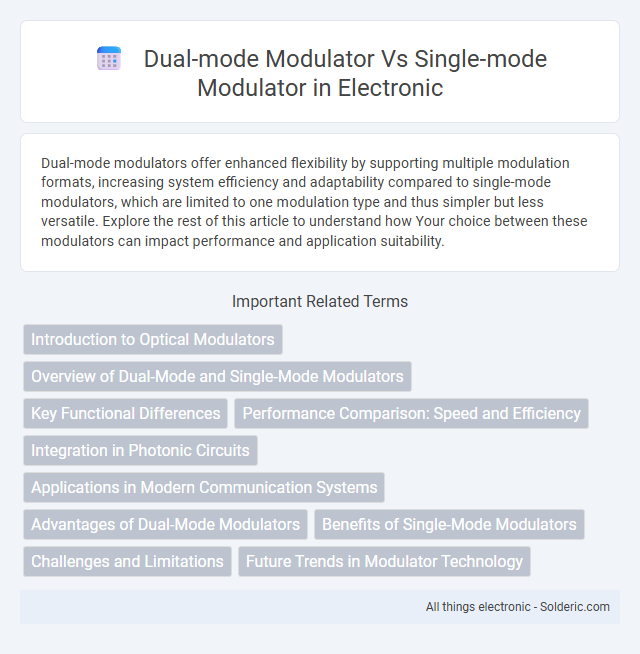Dual-mode modulators offer enhanced flexibility by supporting multiple modulation formats, increasing system efficiency and adaptability compared to single-mode modulators, which are limited to one modulation type and thus simpler but less versatile. Explore the rest of this article to understand how Your choice between these modulators can impact performance and application suitability.
Comparison Table
| Feature | Dual-mode Modulator | Single-mode Modulator |
|---|---|---|
| Operating Modes | Supports two distinct modulation modes | Supports only one modulation mode |
| Complexity | Higher complexity due to mode management | Simple architecture, easier to design |
| Flexibility | Increased flexibility for various applications | Limited to single-use scenarios |
| Cost | Generally higher cost due to advanced features | Lower cost, more affordable |
| Performance | Optimized for applications requiring multiple modes | Optimized for single-mode efficiency |
| Use Cases | Telecommunications, adaptive systems, optical networks | Basic signal modulation, simple communication devices |
Introduction to Optical Modulators
Optical modulators control the intensity, phase, or polarization of light signals in fiber optic communication. Dual-mode modulators enable simultaneous modulation of two optical signals, enhancing data capacity and system flexibility, whereas single-mode modulators focus on a single light mode for simpler and more cost-effective applications. Choosing between dual-mode and single-mode modulators depends on your network's performance requirements and budget constraints.
Overview of Dual-Mode and Single-Mode Modulators
Dual-mode modulators combine two modulation formats in a single device, enhancing flexibility and spectral efficiency for advanced optical communication systems. Single-mode modulators operate using a single modulation technique, offering simplicity and lower insertion loss, ideal for straightforward, cost-effective applications. Your choice between dual-mode and single-mode modulators impacts system performance, integration complexity, and overall cost-effectiveness based on specific network requirements.
Key Functional Differences
Dual-mode modulators offer the versatility of operating with two distinct modulation formats or frequencies, providing greater adaptability for complex communication systems. Single-mode modulators, by contrast, focus on a single modulation type, optimizing performance for specific applications such as simple data transmission or fixed-frequency operation. Your choice depends on whether flexibility or optimized simplicity is paramount in your modulation requirements.
Performance Comparison: Speed and Efficiency
Dual-mode modulators exhibit superior speed and efficiency compared to single-mode modulators by enabling simultaneous propagation of multiple optical modes, which enhances data throughput and reduces signal distortion. Single-mode modulators provide high spectral purity and low dispersion but are limited in modulation bandwidth and power efficiency. Advanced dual-mode designs leverage mode coupling and interference effects to achieve faster modulation speeds with lower energy consumption, making them ideal for high-performance optical communication systems.
Integration in Photonic Circuits
Dual-mode modulators offer enhanced integration in photonic circuits by simultaneously handling two optical modes, increasing data throughput and enabling complex signal processing on a single chip. Single-mode modulators are simpler and consume less power but limit integration density and functionality within photonic circuits. Your choice depends on the application's need for bandwidth, complexity, and integration level in photonic systems.
Applications in Modern Communication Systems
Dual-mode modulators are preferred in modern communication systems for their ability to efficiently switch between modulation schemes, enhancing compatibility and flexibility across diverse network standards such as 4G LTE and 5G NR. Single-mode modulators, typically optimized for one specific modulation format, are often utilized in specialized applications where simplicity, lower cost, and minimal power consumption are critical, such as in narrowband IoT devices. The adaptability of dual-mode modulators makes them ideal for advanced wireless networks requiring dynamic spectrum allocation and multi-protocol support.
Advantages of Dual-Mode Modulators
Dual-mode modulators offer enhanced flexibility and improved bandwidth efficiency compared to single-mode modulators by allowing simultaneous modulation of two distinct optical modes. This capability enables more complex signal processing and higher data transmission rates in optical communication systems. Dual-mode modulators also provide better noise immunity and reduced crosstalk, resulting in superior signal quality and system performance.
Benefits of Single-Mode Modulators
Single-mode modulators offer superior signal integrity by minimizing dispersion and maintaining a consistent optical path, resulting in higher bandwidth and longer transmission distances. Their compatibility with single-mode fibers reduces signal loss and enhances performance in high-speed communication systems. You benefit from increased efficiency and reliability, making single-mode modulators ideal for advanced telecommunications and data center applications.
Challenges and Limitations
Dual-mode modulators face challenges such as increased complexity in design and signal processing compared to single-mode modulators, leading to higher manufacturing costs and potential reliability issues. They also exhibit limitations in bandwidth efficiency and are more susceptible to mode crosstalk and noise interference, which can degrade signal quality. Single-mode modulators offer simpler implementation and better performance in stable environments but lack the flexibility and multi-functional capabilities of dual-mode systems.
Future Trends in Modulator Technology
Dual-mode modulators are emerging as a pivotal trend in optical communication for their ability to simultaneously handle multiple signal formats, increasing bandwidth efficiency and reducing system complexity compared to single-mode modulators. Advances in integrated photonics and materials science are enabling higher modulation speeds and lower power consumption in dual-mode modulators, catering to the demands of next-generation 5G and beyond networks. The shift towards programmable and multi-functional modulators is expected to accelerate, driven by the need for adaptable and scalable solutions in evolving communication infrastructures.
Dual-mode modulator vs single-mode modulator Infographic

 solderic.com
solderic.com